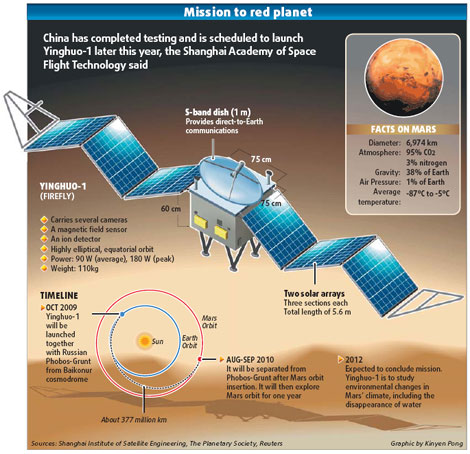
|
CHINA> National
 |
|
Mars probe set for Oct launch
By Xin Dingding (China Daily)
Updated: 2009-06-09 07:18 China's first Mars probe will have to stand the test of nearly nine hours in the freezing, dark shadow of the red planet during its one-year mission - the longest such period in exploration history - the scientist in charge of the probe's design has said. 
To conserve energy, part of the facilities on board will have to be switched off, and the probe will restart the facilities when the probe enters into sunshine, Chen said. Should anything go wrong, the orbiter could become "frozen" - like the United States' Phoenix Lander, which froze on the surface of the planet. Chen said he is relieved after the 110-kg micro satellite managed to survive lab tests in February that strictly simulated the Mars environment - 260 C below zero in the dark. His team has spent only 23 months on the satellite design, which typically takes three years or longer. After passing the research phase, Yinghuo-1 is ready to be transported to Moscow for compatibility tests, and will blast off atop a Russian launch vehicle from Baikonur Cosmodrome in Kazakhstan in October, Chen said. According to earlier reports, Yinghuo-1 will separate from the Russian landing craft Phobos-Grunt after a 10-month journey and stay in a Martian orbit while the latter continues on to Phobos, the larger and the closer of the planet's two moons. Chen said Yinghuo-1's orbital path is determined by Phobos-Grunt, and is different from the orbits of other countries' probes. Though China is relying on Russia for the launching, tracking and controlling of the micro-satellite, the Mars probe project is still regarded as a milestone that will take the country one big step further in deep-space exploration. Pang Zhihao, a researcher with the China Academy of Space Technology, said: "If Yinghuo-1 enters the preset orbit smoothly and works well, China will become only the fourth country or region that has ever succeeded in launching a Mars probe, following the United States, Russia and Europe." Its mission to explore the Martian space environment is also expected to fill in a blank in research, Pang said. Other countries usually focus on looking for signs of life, the weather on Mars and geological research. Yinghuo-1 is expected to provide clues as to whether the sun turned Mars dry by studying the relationship between oxygen molecules and solar winds. The probe will carry several cameras, a magnetic field sensor and an ion detector. The distance between Mars and Earth is between 56.7 million km and 400 million km, depending on their orbital positions. Yinghuo-1 will travel 350 million km over 11 months before entering the planet's orbit, and is expected to send back the first images of the red planet in September next year. However, the project is unlikely to achieve optimal results because its orbit entry point is not close enough to Mars, Ye Peijian, chief designer of the nation's first moon probe, told China Daily earlier. The country could explore Mars independently if it developed launch technology, and use the tracking experience from the lunar mission, he said. Jiao Weixin, a space scientist at Peking University, cautioned that the failure rate of Mars missions is high - of the more than 30 orbiters launched, about two-thirds have failed. Currently, only three orbiters and two rovers are operating. |